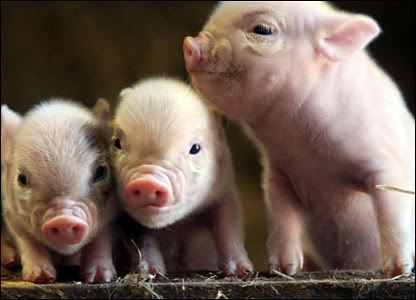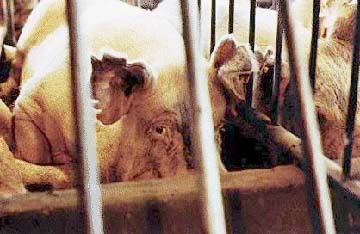One Voice

Most people don't have the privilege of getting to know a pig. For most of us, the thought of pigs conjure images of dirty, greedy animals living in their own waste. We couldn't be more wrong! Pigs don't perspire, and so wallow in mud to keep themselves cool. They are naturally very clean animals and, if given the choice, they prefer to cool themselves down in fresh water. When in a natural environment, pigs build communal nests and toilet areas away from their sleeping area
"I like pigs.. Dogs look up to us. Cats look down on us. Pigs treat us as equals. "
British politician and Nobel Prize Laureate Winston Churchill

Smarter than Dogs?
Pigs are remarkably intelligent creatures thought by many to be smarter than dogs. They can be trained to respond to simple voice commands, and are easily toilet trained. Studies have revealed that pigs have a long memory and are able to focus on specific tasks even better than some primates. Research conducted at Bristol University found that pigs are cleverly competitive with other members of their herd, and to avoid confrontation will wait until nobody is looking to sneak away hidden food. "This sort of behaviour suggests that pigs can compete with each other in quite complex and 'cerebral' ways," says Dr Mendl of Bristol University.
"[Pigs] have the cognitive ability to be quite sophisticated. Even more
so than dogs and certainly three-year-olds. "
Professor Donald Broom of Cambridge University Veterinary School

Playful Pigs
Pigs develop highly complex social structures and form strong bonds with other members of their group. At the age of around 3 weeks, piglets begin to play with other piglets, and for the majority of weeks thereafter will interact more with each other than with other members of their herd. It is during this time of play and interaction that strong bonds are formed, often lasting the duration of their lives

Mother and Child
About 24 hours before giving birth, pregnant mother pigs will temporarily leave the social group in order to collect branches and soft material to build a nest. Shortly after giving birth, piglets will often move to the head of the sow and touch noses, vocalise, and then begin suckling. The mother will stay isolated in her nest with her newborns for the first week, which allows her to develop a strong bond between herself and her piglets. Mothers are known to 'sing' to their offspring, which is believed to inform them when her milk is flowing.
A Healthy Appetite
Most of a pig's day is spent foraging and eating. The end of their snout contains has many tactile receptors as the human hand, and is a highly specialised and sensitive tool. This, along with their exceptional sense of smell, enables pigs to locate and uncover tasty treats such as seeds, roots, and truffles. Unlike dogs or humans, pigs never dangerously overeat-even when given access to unlimited food.
Pigs are affectionate, protective, playful,
intelligent and social animals
who suffer tremendously within
intensive farming systems. …Behind closed doors
LIES THE
CRUEL TRUTH  Approximately 100 million pigs are raised and slaughtered in the US every year. As babies, they are subjected to painful mutilations without anesthesia or pain relievers. Their tails are cut off to minimize tail biting, an aberrant behavior that occurs when these highly-intelligent animals are kept in deprived factory farm environments. In addition, notches are taken out of the piglets' ears for identification. By two to three weeks of age, 15% of the piglets will have died. Those who survive are taken away from their mothers and crowded into pens with metal bars and concrete floors. A headline from National Hog Farmer magazine advises, "Crowding Pigs Pays..", and this is exemplified by the intense overcrowding in every stage of hog confinement systems. Pigs will live this way, packed into giant, warehouse-like sheds, until they reach a slaughter weight of 250 pounds at 6 months old. The air in hog factories is laden with dust, dander, and noxious gases, which are produced as the animals' urine and feces builds up inside the sheds. Studies of workers in swine confinement buildings have found sixty percent to have breathing problems, despite their spending only a few hours a day inside confinement buildings. For pigs, who spend their entire lives in factory farm confinement, respiratory disease is rampant.
Approximately 100 million pigs are raised and slaughtered in the US every year. As babies, they are subjected to painful mutilations without anesthesia or pain relievers. Their tails are cut off to minimize tail biting, an aberrant behavior that occurs when these highly-intelligent animals are kept in deprived factory farm environments. In addition, notches are taken out of the piglets' ears for identification. By two to three weeks of age, 15% of the piglets will have died. Those who survive are taken away from their mothers and crowded into pens with metal bars and concrete floors. A headline from National Hog Farmer magazine advises, "Crowding Pigs Pays..", and this is exemplified by the intense overcrowding in every stage of hog confinement systems. Pigs will live this way, packed into giant, warehouse-like sheds, until they reach a slaughter weight of 250 pounds at 6 months old. The air in hog factories is laden with dust, dander, and noxious gases, which are produced as the animals' urine and feces builds up inside the sheds. Studies of workers in swine confinement buildings have found sixty percent to have breathing problems, despite their spending only a few hours a day inside confinement buildings. For pigs, who spend their entire lives in factory farm confinement, respiratory disease is rampant. 
Modern breeding sows are treated like piglet-making machines. Living a continuous cycle of impregnation and birth, each sow has more than 20 piglets per year. After being impregnated, the sows are confined in gestation crates — small metal pens just two feet wide that prevent sows from turning around or even lying down comfortably. At the end of their four-month pregnancies, they are transferred to similarly cramped farrowing crates to give birth. With barely enough room to stand up and lie down and no straw or other type of bedding to speak of, many suffer from sores on their shoulders and knees. When asked about this, one pork industry representative wrote, "..straw is very expensive and there certainly would not be a supply of straw in the country to supply all the farrowing pens in the US"  Numerous research studies conducted over the last 25 years have pointed to physical and psychological maladies experienced by sows in confinement. The unnatural flooring and lack of exercise causes obesity and crippling leg disorders, while the deprived environment produces neurotic coping behaviors such as repetitive bar biting and sham chewing (chewing nothing).
Numerous research studies conducted over the last 25 years have pointed to physical and psychological maladies experienced by sows in confinement. The unnatural flooring and lack of exercise causes obesity and crippling leg disorders, while the deprived environment produces neurotic coping behaviors such as repetitive bar biting and sham chewing (chewing nothing). 
After the sows give birth and nurse their young for two to three weeks, the piglets are taken away to be fattened, and the sows are re-impregnated. An article in Successful Farming explains, "Any sow that is not gestating, lactating or within seven days post weaning is non-active," and hog factories strive to keep their sows '100 % active' in order to maximize profits. When the sow is no longer deemed a productive breeder, she is sent to slaughter. The overcrowding and confinement is unnatural and stress-producing since pigs are actually very clean animals. If they are given sufficient space, pigs are careful not to soil the areas where they sleep or eat. But in factory farms, they are forced to live in their own feces, urine, vomit and even amid the corpses of other pigs. In addition to overcrowded housing, sows and pigs also endure extreme crowding in transportation, resulting in rampant suffering and deaths. As one hog industry expert writes:  Death losses during transport are too high — amounting to more than $8 million per year. But it doesn't take a lot of imagination to figure out why we load as many hogs on a truck as we do. It's cheaper. So it becomes a moral issue. Is it right to overload a truck and save $. 25 per head in the process, while the overcrowding contributes to the deaths of 80,000 hogs each year?
Death losses during transport are too high — amounting to more than $8 million per year. But it doesn't take a lot of imagination to figure out why we load as many hogs on a truck as we do. It's cheaper. So it becomes a moral issue. Is it right to overload a truck and save $. 25 per head in the process, while the overcrowding contributes to the deaths of 80,000 hogs each year? 
Prior to being hung upside down by their back legs and bled to death at the slaughterhouse, pigs are supposed to be 'stunned' and rendered unconscious, in accordance with the federal Humane Slaughter Act. However, stunning at slaughterhouses is terribly imprecise, and often conscious animals are hung upside down, kicking and struggling, while a slaughterhouse worker tries to 'stick' them in the neck with a knife. If the worker is unsuccessful, the pig will be carried to the next station on the slaughterhouse assembly line
— the scalding tank —
where he/she will be boiled, alive and fully conscious
Please think
before you eat another sausage link!!
One Voice


























0 Comments:
Post a Comment